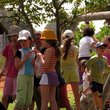Home > Oasis of Peace > Projects & Outreach > Children’s Educational System > The School in May 2009: The Shavuot Holiday and a field trip
The School in May 2009: The Shavuot Holiday and a field trip
May 2009, by

Grade 3&4 visit Haifa and the North
May 20th 2009: The third and fourth grade visited Haifa, prehistoric caves, and the village of Usfiyya.
We trekked north, climbing to caves inhabited some 200 million years ago. After exploring the caves, the children learnt how people lived using animal skins for clothing and flint tools, in a fine example of Stone Age civilisation. The magnificent caves, hidden high, winding further and darker deep into the mountains, served as both shelter from the cold of the winter and as a cool oasis away from the summer heat.
The northern trek continued to Haifa, where we entered the topmost of the pristinely kept Baha’i gardens and looked out over the port. The children heard about the shipping industry of the town, and where ships sail to.
We travelled south from Haifa, and inland to clamber slowly through lush green hills. Our final port of call was the beautiful town of Usfiyya, perched loftily above wonderful scenes of forest and farmland, where the children were invited to see the local olive press and to learn about the Druze religion and traditions. The olive press is in the middle of the old town, among the cool stone houses with doorways gently coloured in fading green and blue, and the streets paved with cold sand coloured stone.
The Druze guides met the group, showed them the olive press and told them about the village. They talked about the Druze people and their traditions. They also explained how even though the Druze religion is related to Islam, some of their customs are very different, and for instance people don’t fast during Ramadan. Some of the children asked the guides questions about the Druze. They found out that what each of the colours in the Druze star symbolize, and that in order to be Druze both your mother and your father have to be Druze. We continued walking through the town, and met some local residents. The pupils noticed a lot of people in the traditional blue dress, and how although a lot of the men wear moustaches and some of the women cover their hair with white scarves, there are many different styles of dress among the young.
The bus took everyone back to WASNS along the coast where the early evening sun was dropping into the sea.
Celebrating Shavuot
Wednesday 27th May: The Jewish spring holiday of Shavuot, also known as Pentecost, comes 50 days after Passover and celebrates the handing of the laws to Moses on Mount Sinai. Because it coincides with the harvest of wheat grain in Israel, it is sometimes called the Day of the First Fruits, and the Festival of Reaping. Traditionally people celebrate Shavuot with a celebratory meal, and usually make loaves of bread, to mark the wheat harvest. Many people also eat desserts abd dishes made from dairy products, like cheesecake. Some say this originated from King Solomon’s description of the Torah as "honey and milk … under your tongue" (Song of Songs 4:11). Some observe other customs such as engaging in all-night study (of the Torah), and reading special prayers and poems, and passages from the book of Ruth.
Children celebrate this holiday by throwing water at each other, and this tradition probably originates from another comparison of the Torah to “living waters.” The day before Shavuot the children learnt about the holiday in class, and then had some fun using junk from the Eco-Art classroom to make bubbles from soapy water outside in the playground.